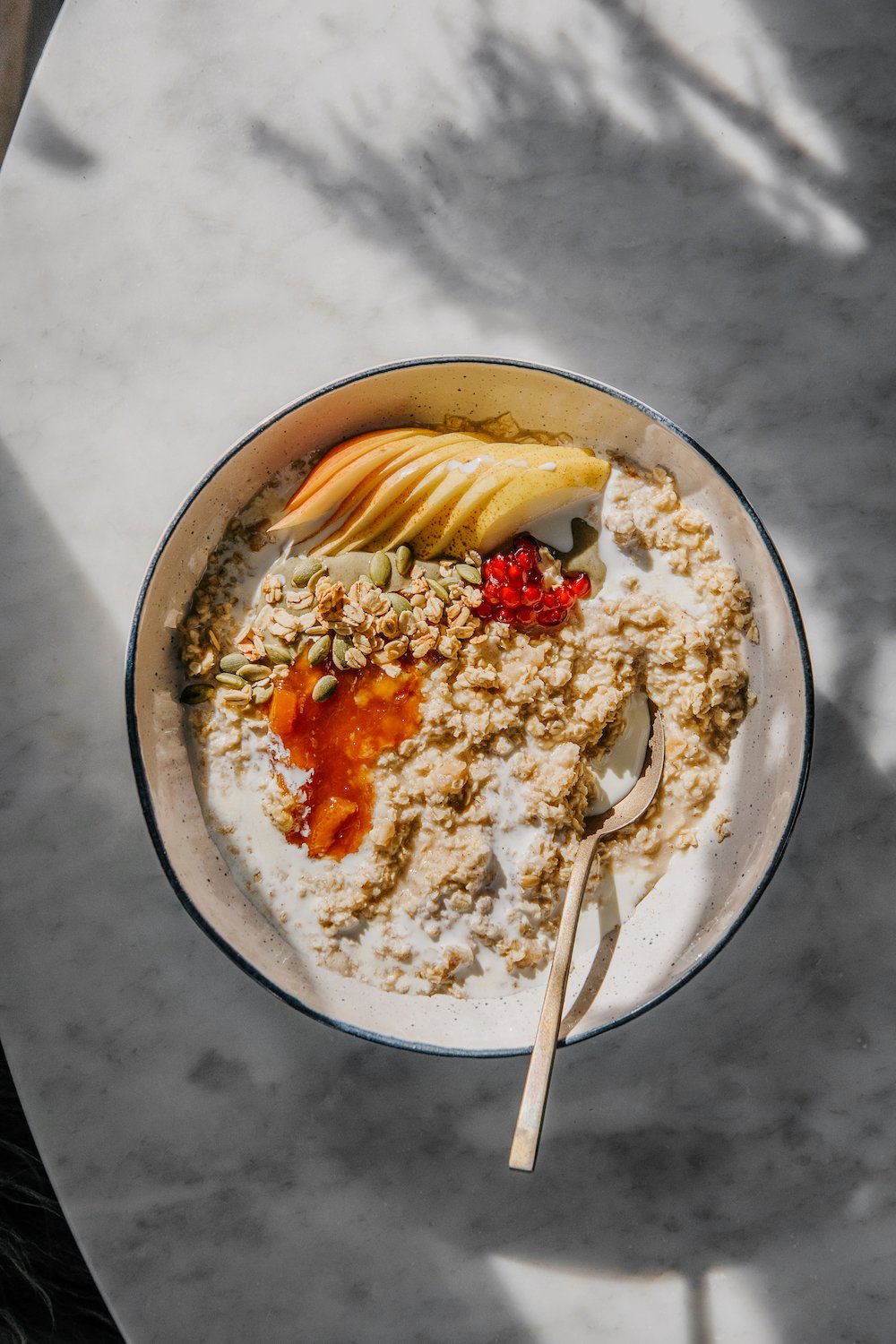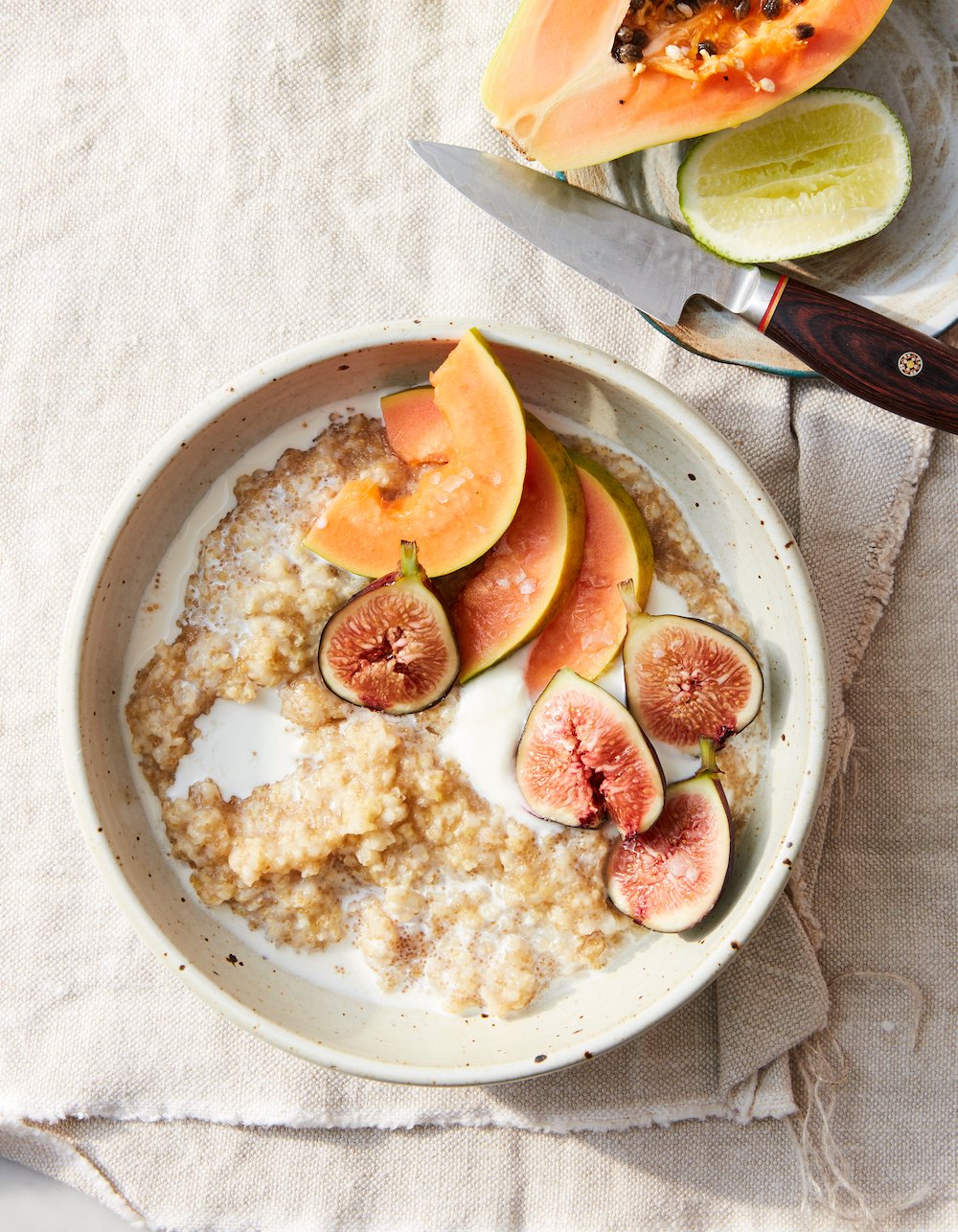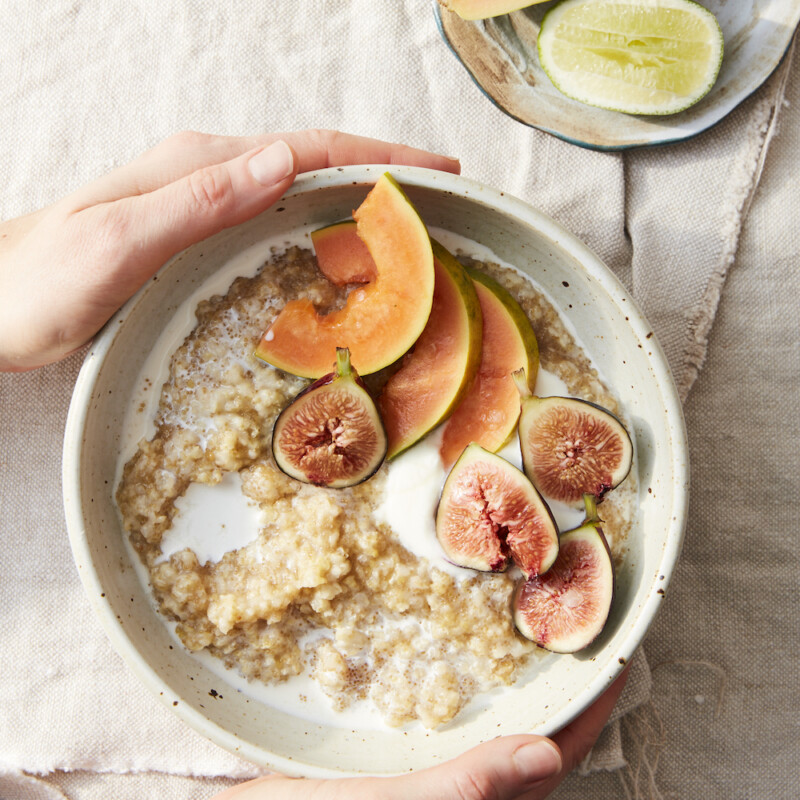We’re big fans of Sarah Copeland’s deliciously simple take on food. The award-winning writer, tastemaker, and curator of good living recently launched her new book, Instant Family Meals with 75 delicious time-saving recipes—and we’re hooked! In this article, Copeland shares her tips on how to make porridge with an exclusive recipe—it’s not just oatmeal. It’s our new go-to breakfast and we know it will be yours now too. You’re welcome!
The dreamiest porridge mornings take a little forethought, but hardly any work, making this a go-to breakfast that will get us through the day like a warm hug.
If your experience with porridge begins and ends with oatmeal, you’re in for a surprise. One of the most nourishing and delicious morning meals, known throughout the world, has dozens of variations, and I’m almost certain there’s a porridge out there expressly for you.
There are so many grains to keep your warm breakfast bowl exciting and new. You only need to add water, salt, your milk of choice, and a bit of patience, and a good imagination (in the form of various, exciting toppings) to keep a warm bowl of porridge fresh and new, through all the seasons. Read on for my tips and recipe for you to make at home!

TYPES OF GRAINS
Throughout the world (and in my newest book, Instant Family Meals), you’ll find porridge made with rice, oats, millet, and amaranth (though you can make porridge with just about any whole grains including cornmeal, quinoa, barley, Spelt, Kamut, buckwheat groats, wheat berries or farro). I find rice, oats, millet, and amaranth make incredibly easy, likable, and consistently delicious hot cereal.
Sometimes I’ve mixed grains like millet and amaranth, brown rice with white rice, or oats mixed with polenta or cornmeal, in the same pot. Grains are often more enjoyable when mixed half and half; the larger and smaller grains play nicely together, helping to avoid that one-note, gloopy-oat experience some of us remember from our childhood oatmeal. If you have only one type of grain on hand, don’t let that stop you—you can break up the texture of your porridge with luscious toppings (see toppings bar, below).
COOK SLOWLY
Whether you’re cooking your grains on the stovetop, in an Instant Pot (as I have below), or in a slow cooker, the low-and-slow idea applies beautifully to creating creamy porridges. This doesn’t mean an instant pot isn’t your friend here—it is. The steam and pressure in an instant pot break down the grains more easily, but you can still get that low and slow feeling by making sure the ratio of liquid to whole grains is loose and luscious, giving you a dreamier, creamier finish.

MORE SALT, LESS SUGAR
Always add at least a hearty pinch or two of fine sea salt to the water for cooking the grains. A little salt equals a lot more flavor in your finished bowl of grains. I find that when the porridge is properly seasoned from the start, we add less brown sugar, maple syrup, or honey at the table.
TOPPINGS BAR:
Think of porridge like a blank canvas—it’s there for you to create a masterpiece upon. Add a sprinkle of toasted nuts, sliced fruits, luscious jams, and a drizzle of oat milk, say, and you’re well on your way to a magical morning. Use your imagination and this recipe as a starting point. More toppings that my family loves include marmalade, almond butter, honey, maple syrup, fresh figs, fresh or dried berries, bee pollen, flax seeds, toasted coconut, toasted sliced almonds, fresh persimmon, red currants, leftover cranberry relish. Or go savory, with shredded chicken, scallions, and a fried egg. Now dream up your own bowl—there are no wrong answers here.

WINNER, WINNER PORRIDGE DINNER
Around the world, porridges such as Congee serve as more than just a morning meal. Whether you like your porridge sweet or savory, it’s a great back-pocket fix for dinners on cold winter or rainy spring nights, or any evening dinner feels like a chore. A one pot-bowl-of-comfort always wins.
About My Millet and Amaranth Porridge With Figs and Papaya Recipe…
Millet and amaranth are high-nutrient, texture-rich grains that cook into a creamy porridge and take on almost any flavor you want to bestow upon them. Here I mix the dense, pearl-like millet with tiny amaranth (no bigger than the tip of a pen) for a creamy, pudding-like texture that my kids adore. On the stovetop, these grains require long cooking and lots of babysitting, but an electric pressure cooker eliminates the stirring work and halves the cooking time.
This is especially inviting with papaya or fig—the warm and sunny flavors of the fruit do a great job brightening up a wintry bowl of porridge. But millet and amaranth equally take to sliced bananas, stewed fruits (page 000), marmalades, and jams, as well as to any milk (cow’s or nut) you’re craving. If you don’t have fresh fruit on hand, try tossing in ½ cup raisins or chopped dried figs at the start; they’ll plump and naturally sweeten the porridge while the grains cook.
For more recipe ideas, get your hands on Sarah Copeland’s Instant Family Meals.
Sarah Copeland's Millet and Amaranth Porridge with Figs and Papaya
Serves 4
Sarah Copeland Says This Is How to Make the Dreamiest Porridge (It's Not Just Oatmeal!)
Prep
10 minutes
Cook
25 minutes
Categories
Excerpted from Instant Family Meals, with permission by Clarkson Potter
Ingredients
- 1/3 cup millet, rinsed
- 1/3 cup amaranth, rinsed
- ½ to 1 teaspoon fine sea salt
- ½ to 1 cup cow’s milk or coconut, almond, soy or oat milk, for drizzling
- 1/3 cup plain whole milk yogurt, homemade (page 000) or store-bought, or kefir
- 2 to 4 fresh figs, sliced or halved
- ½ small papaya, peeled, seeded, and sliced or chopped
- 2 tablespoons honey
- 1 lime, quartered
Instructions
- Add 2 cups of water and the millet, amaranth, and salt to the inner liner of an electric pressure cooker. Lock the lid into place and cook on high pressure for 12 minutes. Let the pressure release naturally (about 10 minutes). Set the cooker to Keep Warm.
- Remove the lid and stir in milk to taste (I like my porridge loose but creamy). Add salt as needed.
- To serve, spoon the porridge into bowls, top with a dollop of yogurt, and finish with fresh fruit and a drizzle of honey. Serve with lime wedges for squeezing over.
- IN THE SLOW COOKER Butter the interior of your slow cooker (grains and porridges tend to stick). Cook the porridge as above, on low for 4 hours.
SERVES 4 (makes 4 cups)





